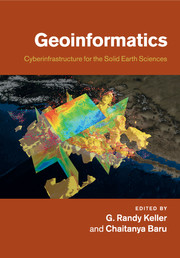Book contents
- Frontmatter
- Contents
- List of contributors
- Preface
- Introduction
- Part I Case studies from other disciplines
- Part II Modeling software and community codes
- Part III Visualization and data representation
- Part IV Knowledge management and data integration
- Part V Web services and scientific workflows
- Part VI Emerging international and other efforts
- 18 It's not your data, it's everyone's: The benefits of a corporate approach to scientific information
- 19 TOPO-EUROPE and cyberinfrastructure: Quantifying coupled deep earth – surface processes in 4-D
- 20 OneGeology – from concept to global project
- 21 Geoinformatics developments in Germany
- 22 iGEON: Networking the Indian geosciences community through GEON
- 23 Geoinformatics in the public service: Building a cyberinfrastructure across the geological surveys
- 24 Application of the US Geoscience Information Network to deploying a national geothermal data system
- Index
- Plate section
- References
24 - Application of the US Geoscience Information Network to deploying a national geothermal data system
from Part VI - Emerging international and other efforts
Published online by Cambridge University Press: 25 October 2011
- Frontmatter
- Contents
- List of contributors
- Preface
- Introduction
- Part I Case studies from other disciplines
- Part II Modeling software and community codes
- Part III Visualization and data representation
- Part IV Knowledge management and data integration
- Part V Web services and scientific workflows
- Part VI Emerging international and other efforts
- 18 It's not your data, it's everyone's: The benefits of a corporate approach to scientific information
- 19 TOPO-EUROPE and cyberinfrastructure: Quantifying coupled deep earth – surface processes in 4-D
- 20 OneGeology – from concept to global project
- 21 Geoinformatics developments in Germany
- 22 iGEON: Networking the Indian geosciences community through GEON
- 23 Geoinformatics in the public service: Building a cyberinfrastructure across the geological surveys
- 24 Application of the US Geoscience Information Network to deploying a national geothermal data system
- Index
- Plate section
- References
Summary
Introduction
The U.S. Department of Energy calls the National Geothermal Data System the “cornerstone” of the Geothermal Technologies Program for the next several years in meeting the leading demand of industry for better and easier access to data. As described in the original Department of Energy Funding Opportunity Announcement (FOA):
The National Geothermal Database will store critical geothermal site attribute information such as temperature at depth, seismicity/microseismicity, fracture maps, drilling data, permeability data, well logs, geophysical surveys, etc. The database should be inclusive of all types of geothermal resources such as hydrothermal, geopressured, Enhanced Geothermal Systems, geothermal fluids co-produced with oil and/or gas, etc. It should also utilize information from existing USGS geothermal resource assessments and DOE funded R&D projects. This standardized set of geothermal resource data will be made available to the public and serve to focus geothermal exploration activities, thereby mitigating investment risks.
DOE further elaborated (http://apps1.eere.energy.gov/geothermal/projects/projects.cfm/ProjectID=27) that:
The NGDS will be able to handle the full range of geoscience and engineering data pertinent to geothermal resources as well as incorporate data from the full suite of geothermal resource types. It will be able to handle data on geothermal site attributes, power plants, environmental factors, policy and procedure data, and institutional barriers. It will provide resource classification and financial risk assessment tools to help encourage the development of more geothermal resources by industry. It will be an easy to use system that meets the needs of the professional and the public for information on geothermal resources.
- Type
- Chapter
- Information
- GeoinformaticsCyberinfrastructure for the Solid Earth Sciences, pp. 350 - 370Publisher: Cambridge University PressPrint publication year: 2011



